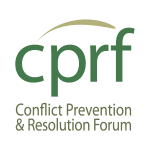Conflict Prevention and Resolution Forum’s 100th Meeting
By Juontel White
Earlier this week I had the pleasure of attending the Conflict Prevention and Resolution Forum, (CPRF). It was the 100th meeting since its inception and this particular event was titled, “The 3Ds in Action: A System-Wide Approach to 21st Century Security.”
It was the final installment of a seven-part series addressing the three Ds—Defense, Diplomacy and Development—as they relate to foreign policy.
This topic alone sets CPRF apart from other forums in Washington for its ongoing examination of how the roles of defense, diplomacy and development are an interconnected means to an end—promoting conflict prevention, stabilization, security, and reconstruction.
Moderator Susan Collin Marks, SFCG’s Senior Vice President along with panelists Louise Diamond Ph. D., President of Global Systems Initiatives; Cynthia Irmer, Senior Conflict Prevention Officer for the U.S. Department of State; and Lisa Schirch, Director of the 3D Security Initiative discussed various aspects of Systems Theory as applied to the 3Ds.
Diamond explained that all living systems exist within a narrative context, which causes them to create stories in search of meaning. Each side in a conflict has its own story/narrative.
Therefore, she added, we must examine the assumptions and listen to the other stories. Diamond stressed the importance of listening for the areas of commonalities between the stories and to make room for new stories to be born.
The second aspect of systems theory is that everything is connected. She used the metaphor of a spider web and how every point of intersection is tied to all points in the web. In this global web we call earth, every country, human, plant and animal life is interconnected.
As Diamond remarked, connections—or relationships—may be linked, but can be seriously strained. She advised that we must look for the places that are disconnected, and connect them, and that we bring in the voices that are missing.
The third aspect of living systems is emergence—the idea that systems organize to best fit their environment. This is often marked by chaos, creative destruction, change and turbulence.
In today’s world, the chaos of global resource depletion, economic turmoil and climate change are all real time examples of how existing systems have been brought to the edge of chaos.
These are examples of old structures being destroyed, so that hopefully the new can be born.
Systems theory is integral to the 3D approach. Because defense, diplomacy and development are interconnected, when used together they help create “a more effective and coordinated response to help states prevent, mitigate and recover from violent conflict,” as stated in a manual on the Interagency Conflict Assessment Framework (ICAF).
ICAF was created by a working group co-chaired by the USAID’s Office of Conflict Management and Mitigation and the Department of State’s Office of the Coordinator for Stabilization and Reconstruction.
It’s a virtual blueprint for applying a systematic, or holistic, approach to conflict resolution and its principles were adopted by the working group in July of last year.
The U.S. Department of Defense recently incorporated a systematic approach to its conflict resolution tactics and as of late, it is one of the few USG agencies to do so.
A major reason for this disparity is that other agencies lack the budget to implement such programs. But as news of its progress spreads, they too hope to have the means to implement new creative approaches to conflict resolution and we should expect to learn more of its impact on U.S. foreign policy in the years to come.








